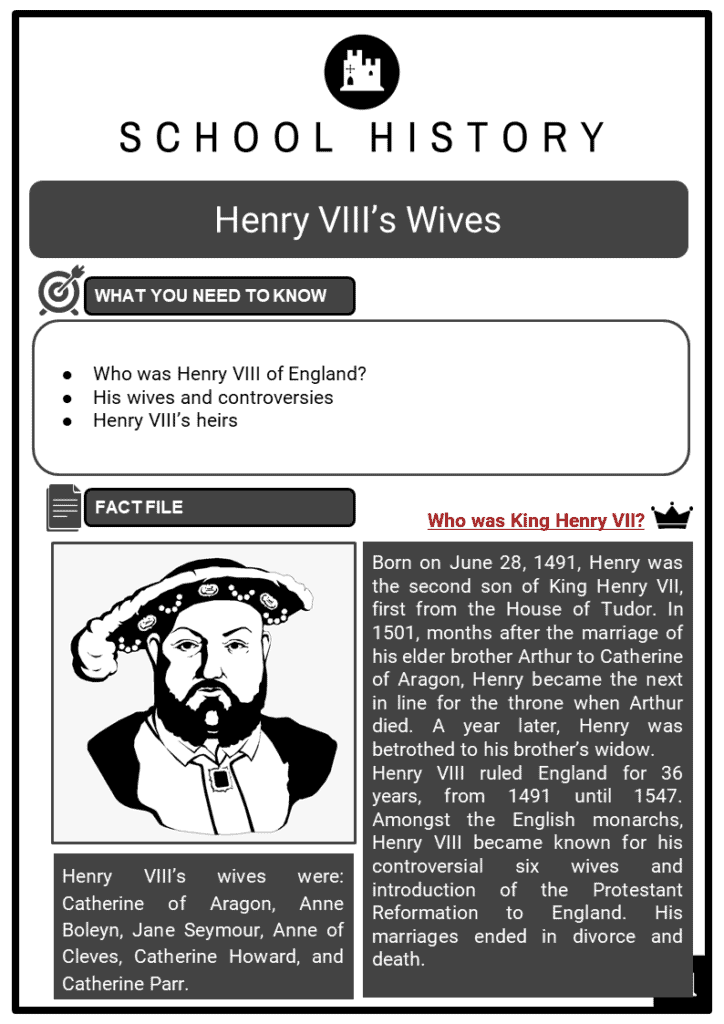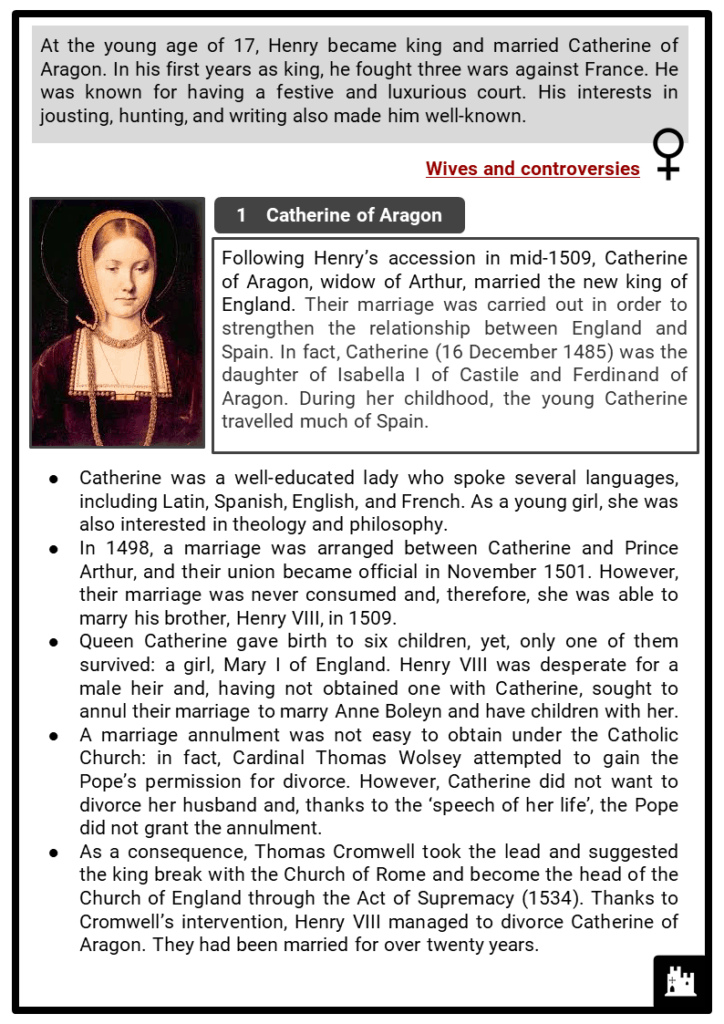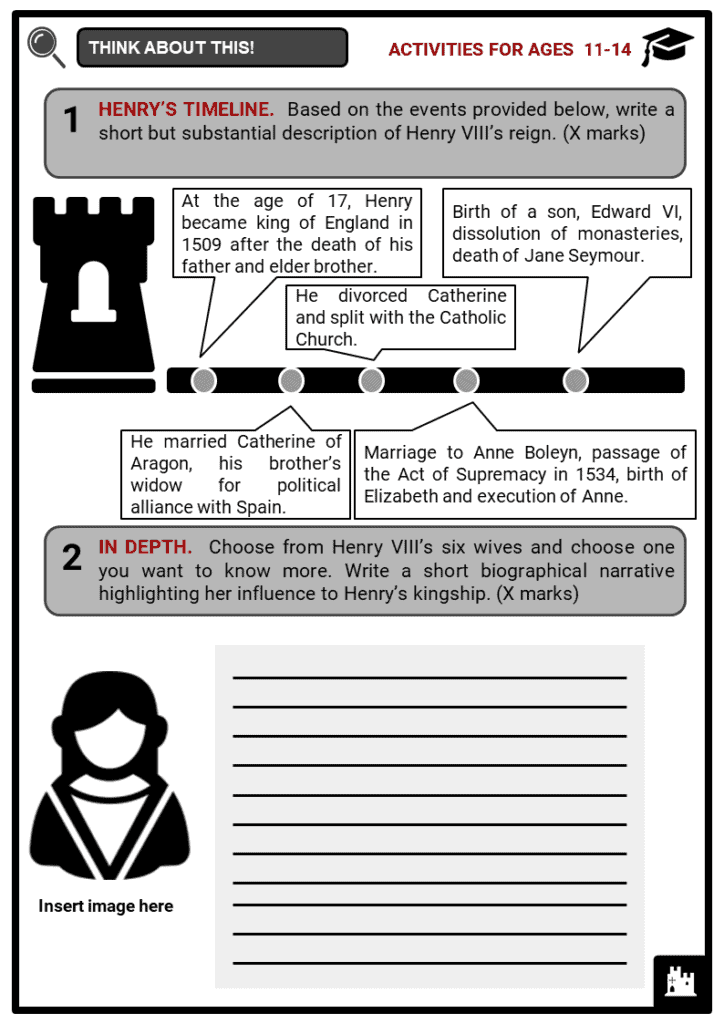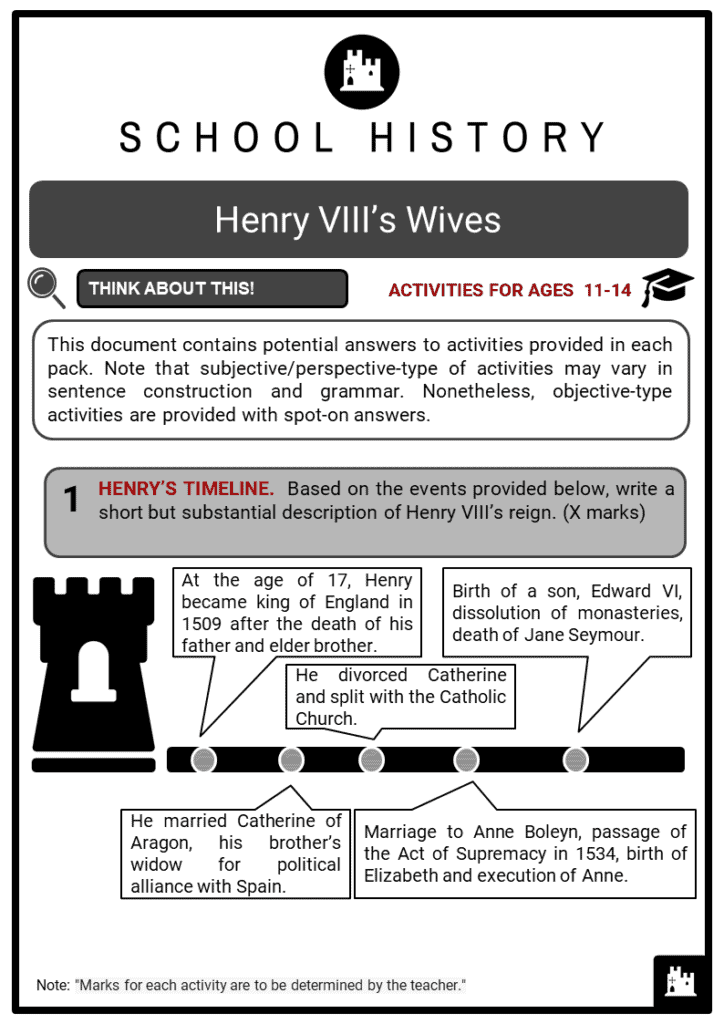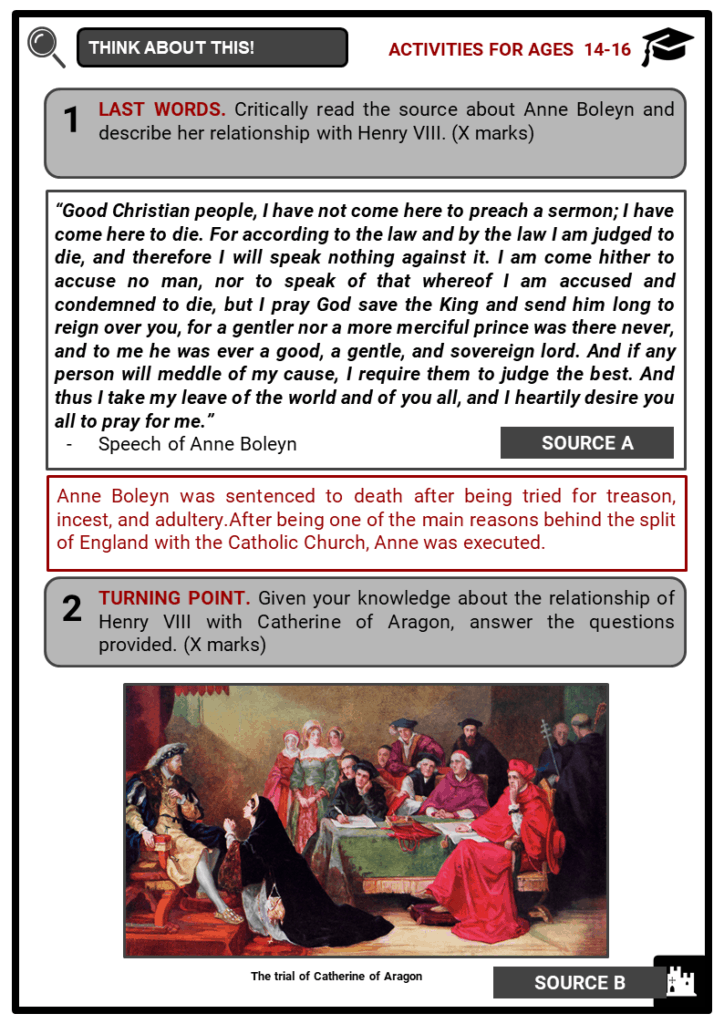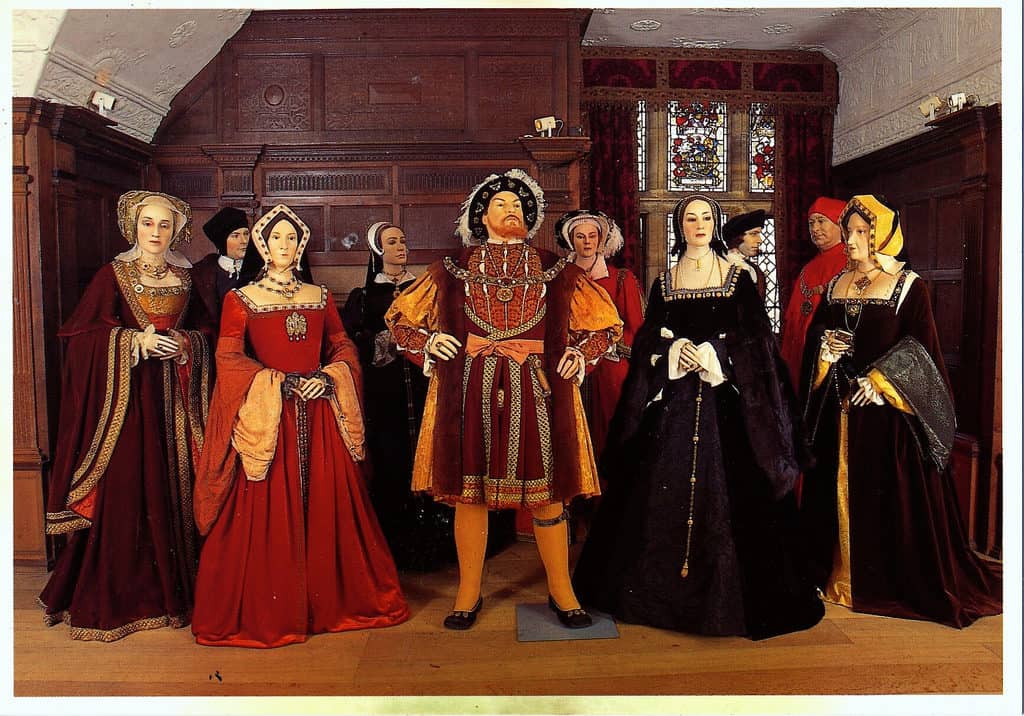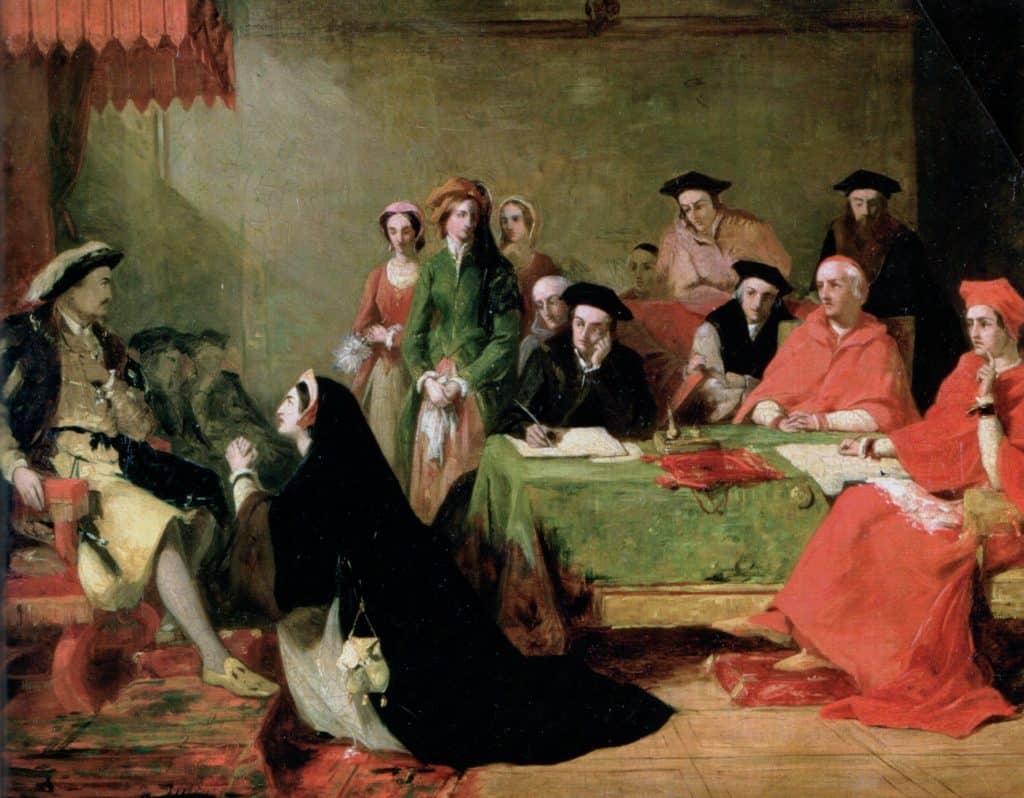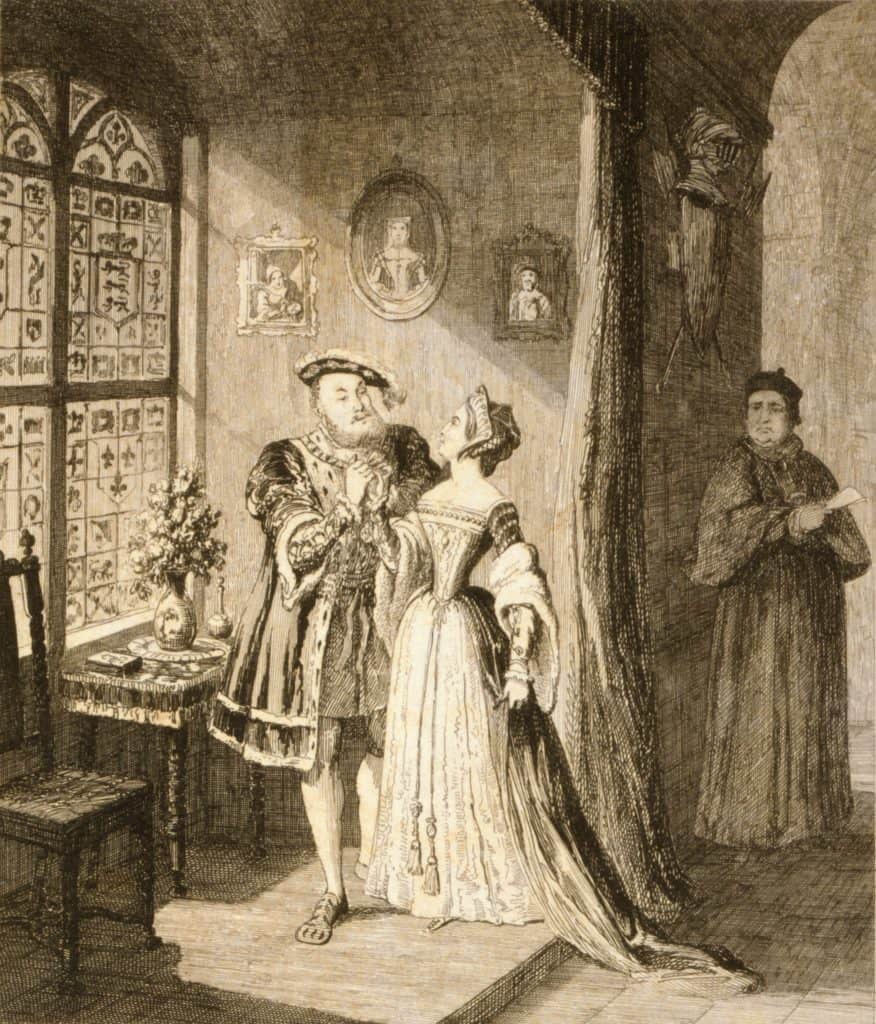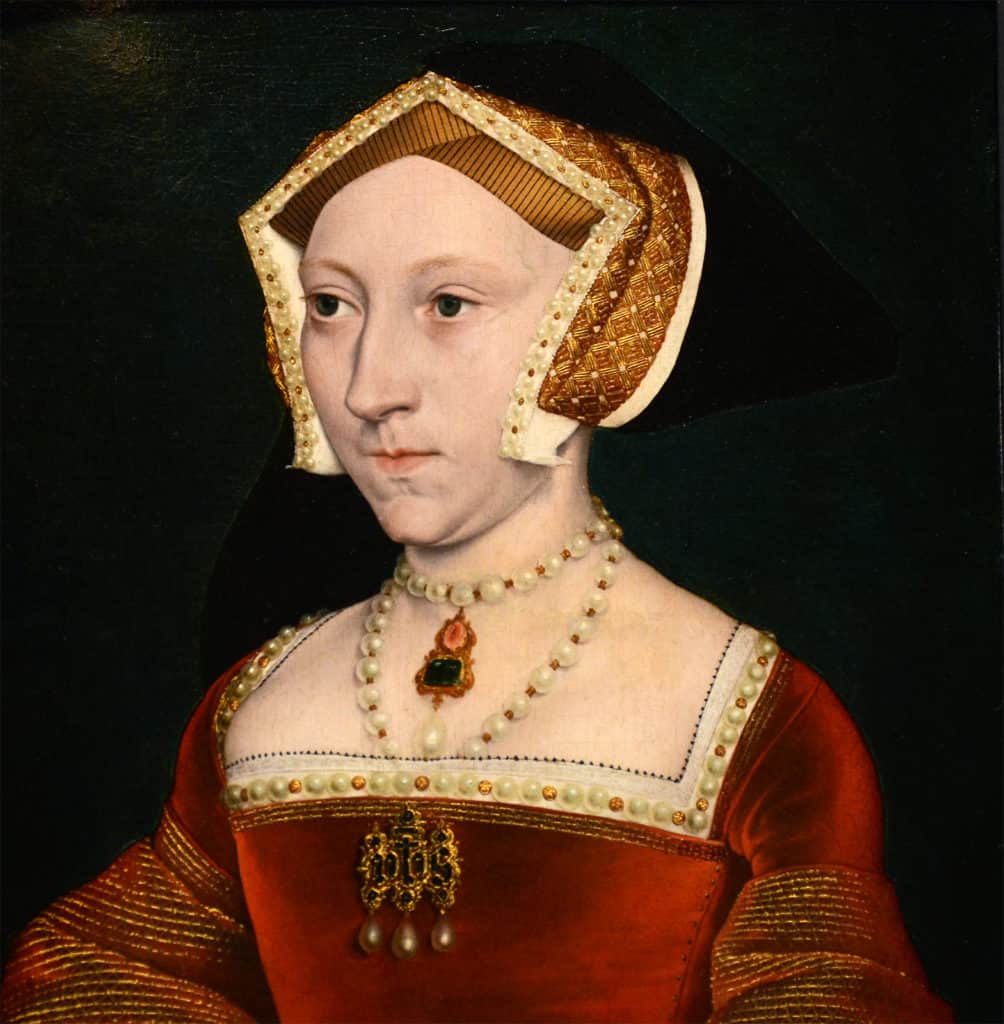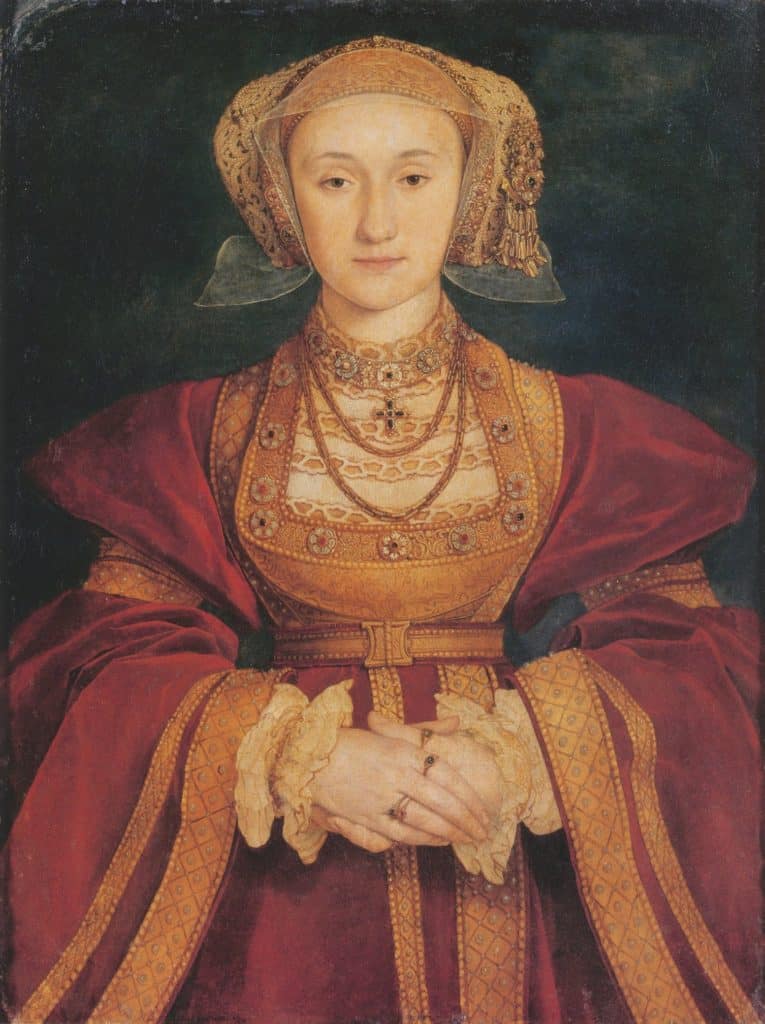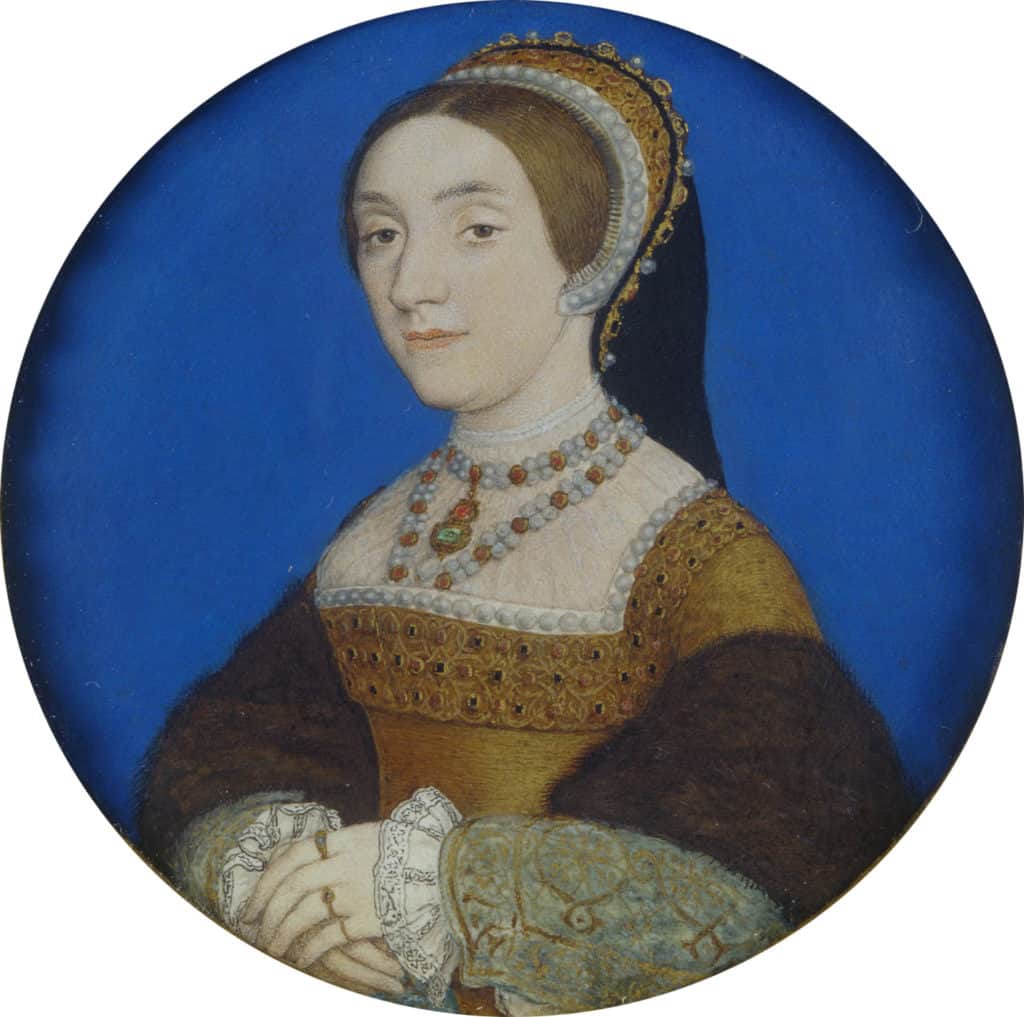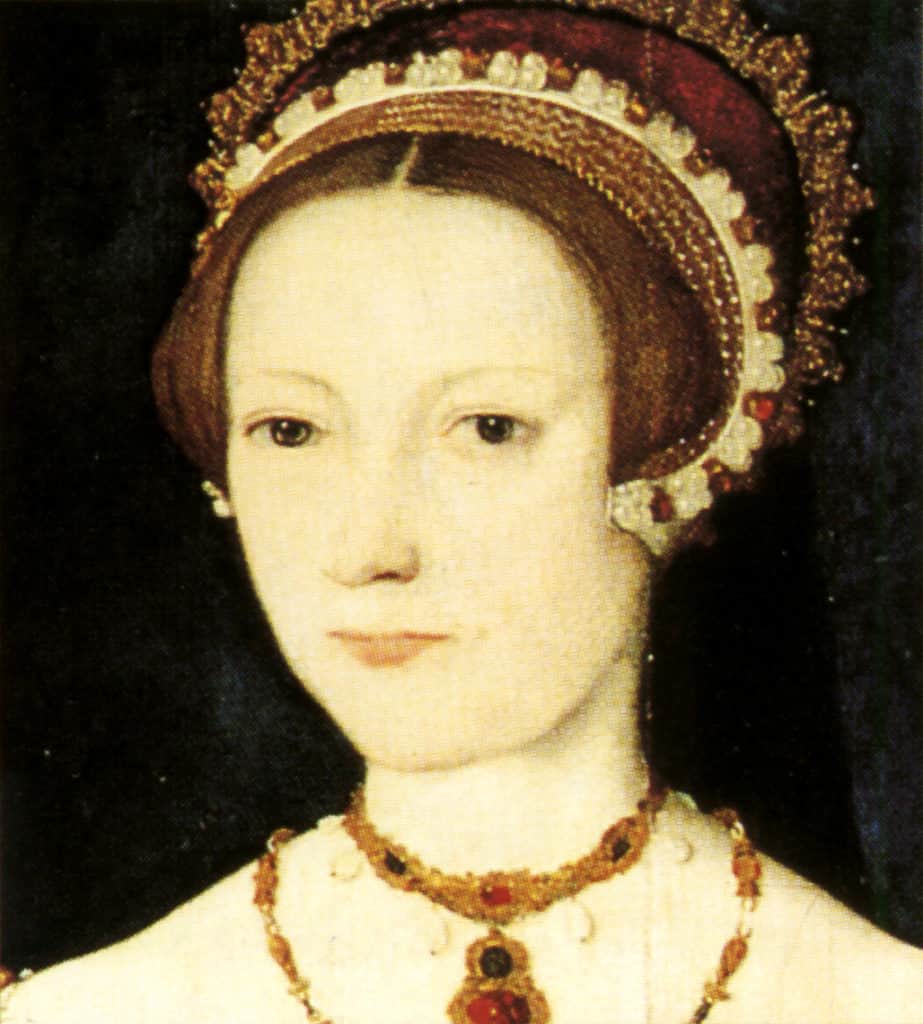Download Henry VIII Wives Worksheets
Do you want to save dozens of hours in time? Get your evenings and weekends back? Be able to teach Henry VIII Wives to your students?
Our worksheet bundle includes a fact file and printable worksheets and student activities. Perfect for both the classroom and homeschooling!
Table of Contents
Add a header to begin generating the table of contents
Summary
Key Facts And Information
Who was King Henry VII?
- Born on June 28, 1491, Henry was the second son of King Henry VII, first from the House of Tudor. In 1501, months after the marriage of his elder brother Arthur to Catherine of Aragon, Henry became the next in line for the throne when Arthur died. A year later, Henry was betrothed to his brother’s widow.
- Henry VIII ruled England for 38 years, from 1509 until 1547. Amongst the English monarchs, Henry VIII became known for his controversial six wives and introduction of the Protestant Reformation to England. His marriages ended in divorce and death.
- Henry VIII’s wives were: Catherine of Aragon, Anne Boleyn, Jane Seymour, Anne of Cleves, Catherine Howard, and Catherine Parr.
- At the young age of 17, Henry became king and married Catherine of Aragon. In his first years as king, he fought three wars against France. He was known for having a festive and luxurious court. His interests in jousting, hunting, and writing also made him well-known.
Catherine of Aragon
- Following Henry’s accession in mid-1509, Catherine of Aragon, widow of Arthur, married the new king of England. Their marriage was carried out in order to strengthen the relationship between England and Spain. In fact, Catherine (16 December 1485) was the daughter of Isabella I of Castile and Ferdinand of Aragon. During her childhood, the young Catherine travelled much of Spain.
- Catherine was a well-educated lady who spoke several languages, including Latin, Spanish, English, and French. As a young girl, she was also interested in theology and philosophy.
- In 1498, a marriage was arranged between Catherine and Prince Arthur, and their union became official in November 1501. However, their marriage was never consumed and, therefore, she was able to marry his brother, Henry VIII, in 1509.
- Queen Catherine gave birth to six children, yet, only one of them survived: a girl, Mary I of England. Henry VIII was desperate for a male heir and, having not obtained one with Catherine, sought to annul their marriage to marry Anne Boleyn and have children with her.
- A marriage annulment was not easy to obtain under the Catholic Church: in fact, Cardinal Thomas Wolsey attempted to gain the Pope’s permission for divorce. However, Catherine did not want to divorce her husband and, thanks to the ‘speech of her life’, the Pope did not grant the annulment.
- As a consequence, Thomas Cromwell took the lead and suggested the king break with the Church of Rome and become the head of the Church of England through the Act of Supremacy (1534). Thanks to Cromwell’s intervention, Henry VIII managed to divorce Catherine of Aragon. They had been married for over twenty years.
Anne Boleyn
- Henry VIII’s request to annul his marriage with Catherine of Aragon to Pope Clement VII was rejected due to the influence of the Holy Roman Emperor Charles V, the Spanish monarch’s nephew.
- Born in 1501, Anne Boleyn was the indirect cause of the Reformation in England. She was the daughter of Thomas Boleyn, the Earl of Wiltshire. She carried out her education in the Netherlands and in France, where she became the maid of honour to Francis I’s wife.
- Although Anne was engaged to the 5th Earl of Northumberland, Cardinal Wolsey refused to marry them, and Anne was obliged to make her way back to her home in Hever Castle.
- In 1526, Henry VIII was struck by Anne’s beauty and charm. The king tried to seduce the young woman numerous times, but she rejected his advances since she did not want to become a mistress. Anne claimed she would succumb to his love only if Henry ended his marriage with Catherine of Aragon.
- The future queen of England supported the Reformation movement as well as William Tyndale’s translation of the Bible (it is necessary to remember, however, that Henry VIII was Catholic and strongly averse to Protestantism).
- In 1528, Anne contracted the sweating disease and almost died. On January 25, 1533, Henry VIII and Anne married, and she was crowned queen of England six months later.
- In September of the same year, the queen gave birth to Elizabeth I, and all her following pregnancies were miscarriages. The love affair between the two quickly soured not only because Anne was not able to give birth to a male heir but also because she disagreed with the religious reforms that the king was enacting.
- In April 1536, Anne Boleyn was arrested for high treason: she was charged with ‘adultery, incest, and plotting to kill the king’. Although Anne had not committed any of the accusations, she was executed, and her last words were ‘Jesus receive my soul; O Lord God have pity on my soul’.
Jane Seymour
- Born sometime between 1504-1509, she was Catherine of Aragon’s lady-in-waiting and also witnessed the relationship between the king and Anne Boleyn. After courting Jane with expensive gifts, on 30 May 1536, Henry and Jane married, and Jane soon gave birth to the king’s greatest wish: a male heir, Edward.
- The birth of Henry’s son was greatly celebrated all throughout England. However, Jane did not live long, and ‘the christening ceremony had begun in her bed-chamber.
- Before dying, the queen suffered from weakness, exhaustion, high fever, and delirium. According to some historians, Jane died because of puerperal sepsis, i.e. childbed fever. Upon her death, Jane received a solemn funeral, and her body was embalmed. Henry was devastated.
Anne of Cleves
- Following Jane Seymour’s premature death, the king wore black until 1538 and did not marry for two years. One of the reasons he did not marry consisted of the fact that the king had gained a bad reputation amongst European noblewomen.
- Therefore, Henry assigned his closest advisors with a mission to travel to Europe with the intention of finding him a new consort.
- Thomas Cromwell suggested Anne of Cleves as a possible candidate: she was German and fully supported Protestantism. According to Cromwell, such union would reinforce the reformation in England.
- The pair never met in person, and Henry was shown a painted portrait of Anne of Cleves. On 6 January 1540, the two met and officially married. Henry refused to consummate the marriage, declaring that he did not find her attractive.
- Henry famously shouted at Cromwell when Cromwell asked the king, ‘how liked you the Queen?’, and he replied ‘I liked her before not well, but now I like her much worse’. Henry VIII executed Cromwell on 28 July 1540, and divorced Anne only four months after their marriage.
- However, the two remained on good terms.
- In fact, after the, Henry VIII was incredibly grateful for Anne’s cooperation, and decided to reward her by offering her manors, estates, and an income of three-thousand pounds per year.
- The king also defined her as a ‘good sister’ and guaranteed her ‘precedence over all ladies in England, except the Queen and [his] daughters’.
- Furthermore, thanks to the financial stability that her divorce had brought her, Anne spent much of her money on gambling and beautiful gowns. She was also allowed to visit the king, spend time with his children and was always welcomed at his banquets.
Katherine Howard
- Katherine is perhaps one of the most controversial wives of Henry VIII. In fact, she is known to have had numerous love affairs. On 28 July 1540, on the same day as Thomas Cromwell’s execution, Henry VIII married Katherine Howard, a beautiful and very young woman. She was gifted expensive jewellery by her new husband, and she officially became queen on August 8.
- Little did Henry know about her past, however. In fact, when she lived in her grandmother’s residence at Tilney, she entertained a love affair with her music teacher, Henry Manox, and subsequently with Francis Dereham.
- Moreover, she entertained an amorous liaison with one of her husband’s favourites, Thomas Culpeper, and brought to court her former lovers Manox and Dereham.
- On 2 November 1541, Katherine’s reckless behaviour was denounced by Archbishop Cranmer to Henry VIII. Howard was not forgiven by the king, and heavy charges were imposed upon her: She was accused of (I) ’unchastity’ before her marriage; (II) the ‘concealing’ of sexual relations before her marriage (considered treason); (III) and engaging in adulterous behaviours (also considered treason). As a result, Howard lost her title of Queen on 23 November 1541.
- Culpeper and Dereham did not have a happy ending, and on December 10 of the same year, they were executed, and their heads were displayed on London Bridge.
- On 21 January 1542, Katherine Howard was condemned to death on charges of treason. Therefore, on 10 February, she was brought to the Tower of London and, three days later, beheaded and buried in the chapel of St. Peter ad Vincula.
Catherine Parr
- Born in 1512, Catherine was the daughter of Sir Thomas Parr (who was a descendant of Edward III), and Maud Green, one of Catherine of Aragon’s ladies-in-waiting. She was passionate about learning and had strong knowledge of French, Italian, and Latin. Throughout her life, Catherine married four times.
- On 12 July 1543, she became Henry VIII’s final wife: the two held a small ceremony at Hampton Court Palace. Thanks to her influence, Henry VIII passed an act that gave his daughters the right of succession to the throne of England.
- However, because of this act, Catherine was arrested since reformists managed to turn the king against his wife. Nonetheless, ‘the quick-thinking Catherine Parr managed to save her head by pleading with Henry and persuading him that she had only argued with him in an attempt to help him forget about the pain caused by his leg ulcer’.
- Parr served as a caring stepmother to Henry’s children.
- In 1547, the king died and Catherine Parr married her former lover Thomas Seymour. After a year, Catherine died.
- According to scholars, Catherine Parr was the most influential of all of Henry’s wives. She was able to restore the court and became instrumental in the legitimacy of Henry’s daughters. In his absence, Henry even appointed the queen as his successor by naming her Queen Regent. Being married four times (Henry as her third husband), Catherine Parr holds the record of the most-married queen of England.
Henry’s heirs
- MARY I
- Coined ‘Bloody Mary’, Mary I of England was the only child of Henry VIII and Catherine of Aragon who survived. Initially, after the divorce of her parents, Mary was labelled as the king’s illegitimate child, thus, could not rule England. When Henry died, his son Edward VI (son of Jane Seymour), who was only nine, ruled England.
- After several years, Edward VI died of illness. Despite many disliking her, Mary secured the crown and made herself Queen of England. Following her mother and husband’s (Philip II of Spain) religion, Mary restored Catholicism to Protestant England at all costs.
- Her aggressive and violent imposition of Catholicism earned her the title “Bloody Mary”. During her five-year reign, over 300 religious dissenters were burned at stake, which later became known as the Marian persecutions. Most were accused of heresy.
- Mary I became the first female ruler of England.
- ELIZABETH I
- Commonly known as the Virgin Queen, Elizabeth, successor of Mary I, was the daughter of Henry VIII and Anne Boleyn. Elizabeth I ruled England for 44 years and asserted the kingdom’s power in Europe. Due to her remarkable accomplishments, historians regard the height of her reign as the Elizabeth Age.
- After the marriage of Henry and Anne was declared invalid, Elizabeth became an illegitimate child.
- Under the care of Catherine Parr, her father’s sixth and last wife, Elizabeth received rigorous education, including classical languages (Latin, Greek, French, and Italian), rhetoric, history, and moral philosophy.
- In 1554, a rebellion against Mary was plotted by Thomas Wyatt who wanted Elizabeth as queen and to restore Protestantism in England. The plot came to Mary’s knowledge and she immediately imprisoned Elizabeth, but was soon released. Wyatt was executed.
- Four years later, upon the death of Mary, who was childless, Elizabeth ascended the throne as Queen of England.
- During her reign, Elizabeth I called for the passage of the Act of Supremacy, which strengthened the Church of England. As a result, Pope Pius V excommunicated Elizabeth.
- In 1588, the English navy was victorious against the Spanish Armada.
- Under her rule, the crown faced threats from her cousin, Mary, Queen of Scots. Many English Catholics considered Mary, daughter of King James V of Scotland, as the rightful heir to the throne.
- After being imprisoned by Elizabeth for almost 20 years, Mary was executed in 1587 for plotting against Elizabeth.
- EDWARD VI
- In 1547, upon the death of his father, Edward VI became King of England. He was Henry’s only son. Due to his age (9 years old), Henry created a regent to rule England on behalf of Edward. After few years of reign, he died from tuberculosis. His advisors had Edward approve the new order of succession which declared Mary an illegitimate child of Henry, thus, passing the throne to Lady Jane Grey.
- For only nine days, Lady Jane ruled as queen but was immediately deposed and executed by Mary I.
Image sources:
[1.] https://farm4.staticflickr.com/3837/14567056623_5e4ae42a60_b.jpg
[7.] https://upload.wikimedia.org/wikipedia/commons/8/81/Catherine_Parr%2C_attributed_to_Master_John.jpg

